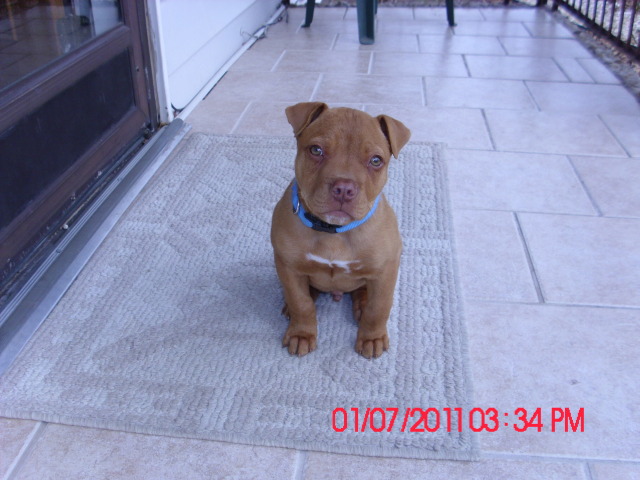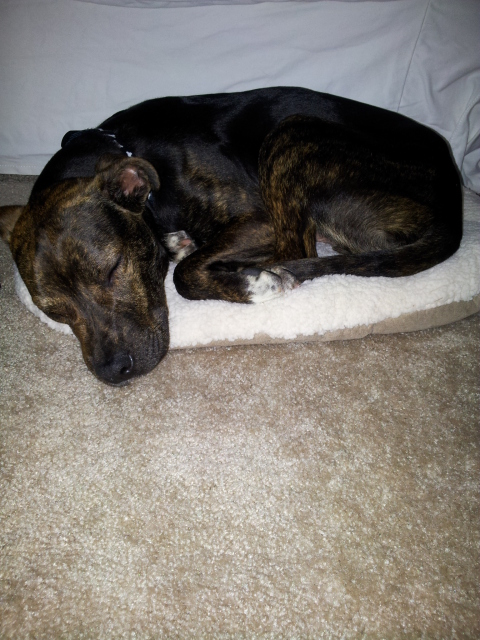QuestionQUESTION: Almost 3 weeks ago I got my dog from the Humane Society. She is a pointer mix, about 9 months old. I am having a really hard time getting her to go to the bathroom outside. I can take her outside and she will sniff around like she is going to go, but she sometimes gets distracted and doesn't go. I always take her to the area where she has gone before. I've tried walking her around the block. Once in awhile she will go right away, and I immediately praise her. I always tell her repeatedly "go potty", but most of the time she wants to go back inside, as soon as I let her back in, she will end up going in the house. There have been times where I have been outside with her for a good 20 minutes, if not longer, and I'm certain that she should have to go because she had alot of water and just got up from a nap. She just wants in the house. I can let her go out with other dogs. They will all run to the grass, do their business and want back in the house, but mine will just stand there on the porch wanting in. I will go stand in the grass with her- nada- she wants the carpet- grrr...Now it's getting cold and she doesn't want to stay outside to go potty, neither do I for that matter. I just want her to go out, get it done, and go inside. We have a heeler that we have trained, but she also wasn't a shelter dog. This is so frustrating...help!!! Also, we have had nights without any accidents, then the next night, there's poop/and or pee all over the house.
We tried to crate her once at night. It was a disaster. She barked and whined (ended up breaking the bark collar), and in the morning, the crate and her both were covered in what I thought was poop (it sure smelled like it), but then she threw up- ended up with a visit to the vet. Not pleasant, and I'm afraid to try that again, bet our other pup will go to her crate as soon as we say "go to bed".
What do I do?? Other than that, she is such a good dog, and she is so eager to please..
ANSWER: Khrystel, have you read the information at http://housetraining.angelfire.com? If not, please do. Much of what you have asked me here I have addressed there. The main thing is that you need to keep a leash on her.
As for the crate issue, you could try an X-pen if you don't want to try and crate her. It was wrong of you to put a bark collar on her when you put her in the crate - what you thought was poo was probably where she expressed her anal glands as a result. The throwing up was also a reaction to the stress.
---------- FOLLOW-UP ----------
QUESTION: I put the bark collar on her, because she was making so much noise and would not stop. The only way she is quiet is if I have her in the bedroom with us. She hates being away from me and gets seperation anxiety, and I couldn't have her barking all night- waking my neighbors.
For the most part, she is on a leash when I take her out. When she isn't on a leash and with the other dogs, we just let them run outside- there's 90+ acres out there where we are at. Even then, she jumps on the doors trying to get in. Last night, we stayed out there in the country and tried to keep her in the mud room in case there was a accident. She was making so much noise, scratching and digging at the door, we had to give in and let her in the bedroom which resulted in me stepping in pee barefoot as soon as I got out of bed.
Putting her on the leash to go pee, is the same as if shes not on a leash, because she does the same thing, which is nothing.
OMG! HELP!
AnswerYou need to establish a better routine with her, as explained on my housetraining web page. Every time you take her out for potty purposes, she needs to be on a leash and your other dogs need to be in the house, so that she does not get distracted. If she does not potty within 5 minutes, take her back inside but leave the leash on her and keep ahold of it if you wish, so that as soon as she starts to potty on the floor you can whisk her back outside immediately.
Is there a specific reason you cannot put her crate in your bedroom so that she does not become so anxious about being in it at night? That's the first thing I would suggest. When you first attempt to crate a puppy or a dog that is not used to it, they are going to protest. You just have to grin and bear it during the adjustment period; once they figure out that whining and barking and carrying on does not get them let out, and does not result in any kind of reaction from >>you<<, and that being in the crate is not harmful to them, they stop protesting and most dogs learn to love their crates. My dogs willingly go into their crates to nap, or when they just want some 'quiet time' to themselves. The crate is like a den. Now, believe me, I KNOW how nerve wracking it can be when you are attempting to crate train a puppy or dog. I've done it many times, with puppies as young as 9 weeks and foster dogs as old as 6 years. The adjustment period varies with each dog, and I will admit that I usually lose quite a bit of sleep during this time, but it's a necessary evil with a dog that is not yet housebroken. You have to confine them somehow during the night, so that you don't wake up and step in a wet spot - or worse.
If crating is out of the question, you could try an X-pen instead, again, in the bedroom because that is where she is most comfortable. You can lay a small tarp or something else that's waterproof down, with an old sheet over top of it, and then put the pen on top of it with her bed against one side. That way, if she gets up and stirs during the night, the sound of her moving around on the tarp will wake you up so you can take her out to potty. If you >>don't<< wake up, the sheet and tarp will keep her from messing on your floor. The sheet will absorb any liquid so that it doesn't just roll around all over the tarp and get everywhere.
OR, you can try tethering her to your bed, on a short lead - no more than 6ft. Place her bed so that she cannot really get off of it to go potty on the floor, and she >>should<< wake you up when she needs to be let out.
I understand why you used the bark collar. I do. I'm sure you were at your wit's end with her barking and whining, but that still doesn't make it right. I am not against the use of electronic collars; I use them myself, and have for many years. However, I would never put a bark collar on a puppy while I was attempting to crate train it, especially one that already exhibits signs of separation anxiety while in the crate. That only serves to make being in the crate a scary and horrible experience, hence the reason she got sick and expressed her anal glands. I >>have<< used a bark collar on a dog in a crate before, but that was to stop her from going ballistic at the cats and other dog(s) whenever they would pass by her crate, because there was no other way that I could effectively correct her for it while she was inside the crate. Another use of the bark collar on a dog in a crate is when I go to certain dog events, so that the dog is not exhausting itself barking in the crate waiting for its turn on the training field or in the competition ring. I would never advocate using a bark collar during crate training. The dog simply needs time to figure out that being in the crate is not so bad after all, and making a fuss does not serve any purpose at all, so it is in the dog's best interests to just chill out and be quiet.
One thing you may want to do is to work on desensitizing the dog to the crate during the day instead of just locking her in there at night. You'll need to move the crate out of the bedroom and into the main living area of your house for this. And you'll need lots of SMALL, yummy treats that she loves. If she likes crunchy treats, those would be ideal because they require a few seconds to eat, as opposed to a soft treat that can just be swallowed (which are preferable for obedience training for that reason). Whatever you use, though, it needs to be something that she absolutely LOVES, so that she will be inclined to go into the crate for it.
All you have to do is to spend just a few minutes with her, several times a day, tossing a treat into the open door of the crate, and praising her for going in to get it. Do NOT close the door of the crate yet. If you do it enough times, most dogs will willingly enter the crate on command and allow you to close the door in just one day.
Repeat repeat repeat, and when she is launching herself into the crate when you toss a treat in, start putting a command to it. Say the command just before you toss the treat into the crate. Repeat repeat repeat until she will go into the crate when you say the command, before you start to toss the treat in. When she'll do that, then you will stop tossing a treat in, and instead you will give it to her once she goes into the crate after you give the command. Do this several times, praising her as you hand her the treat. Then, you can start practicing closing the door.
When you are to the point where you can say the command, she goes in the crate, and you hand her a treat while she's in the crate, you will start gradually, progressively closing the door. The first several times, you will simply hand her the treat and reach up and touch the door. Then, you will start handing her the treat and shutting the door about 1/4 of the way, and immediately opening it back up again. Don't forget the praise!!! Gradually work towards closing the door all the way (without locking it) and opening it right back up. Then, start pausing once you get the door closed (again, do not actually lock it in place), at first for just a half a second, gradually working your way up to several seconds. When she will sit calmly inside the crate while you hold the door closed for 10 seconds, you can start practicing locking it.
When you start locking the door, you will want to start over again with just a second at first, then gradually working your way back up to 10 seconds. When she's fine with the crate door locked and you sitting in front of the crate, start practicing moving away from the crate once you shut and lock the door. Again, start over with just a couple of seconds at first, which should give you time to stand up, count to 1, and squat back down and open the door again. Gradually increase the amount of time (as she is calm! If she becomes anxious, you've gone too fast and you need to go back a step) until you can close and lock the door, stand up, and count 10 seconds.
The next step is actually taking steps away from the crate. As before, you'll start out by just taking one step, then returning and letting her out, then two steps, then three, and so on, until you can actually exit the room without her becoming anxious. At first, you will leave the room only for a second before returning, but your goal is to be able to exit the room for 10 seconds before returning.
This sounds like a lot, I know, but as you progress, each step will take less and less time to move through. Don't forget to praise her as long as she is calm in the crate!!
When you put her in the crate at night, it might also help to give her something to keep her occupied for a little while, such as a Kong that you have smeared peanut butter inside and frozen all day, or a Jumbone or Busy Bone. The most important thing to remember is that you must completely ignore her if she starts making a fuss in the crate, and let her out ONLY when she is quiet and calm.

 Dog unwilling to eat
Question
Maggie
I have a 4 year old daschund female.She
Dog unwilling to eat
Question
Maggie
I have a 4 year old daschund female.She
 mini-schnauzer limping not able to put full weight on leg
Question
Willy
A couple of hours ago, I walked my 14mon
mini-schnauzer limping not able to put full weight on leg
Question
Willy
A couple of hours ago, I walked my 14mon
 puppy medical concerns
Question
Rusty
my 11 week old red nose pit bull at time
puppy medical concerns
Question
Rusty
my 11 week old red nose pit bull at time
 8 month old rescue has crate-phobia
Question
His name is Pepper
Please help. We adop
8 month old rescue has crate-phobia
Question
His name is Pepper
Please help. We adop
 re: dog breed
Question
Dog pic question about
Hi Patti,
I took in a
re: dog breed
Question
Dog pic question about
Hi Patti,
I took in a